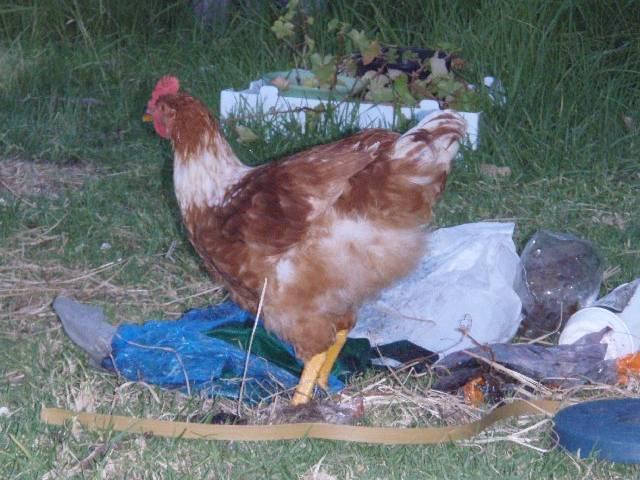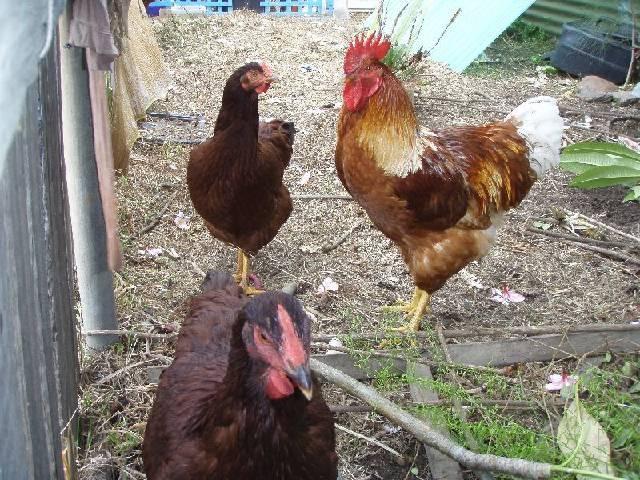Hi,
I hope this is the right forum for this..
I've recently built up a little flock in my backyard of a variety of breeds of chickens (and 2 ducks.. buy they're just trouble). The eldest hens have been laying for a few months now and I want to start incubating some eggs. I'd like to keep breeding my flock and raise a few friendly hens for neighbours and friends, but I want to make sure I improve the genetics of my flock and produce useful offspring.
So far the bizarre little flock includes:
8 month old cock - ISA-Brown (sex-linked RIRxRIW or other unk white)
Two 8 month old pullets - RIRs. One is darker than the other and has some poorly connected feathers on its back (silkie like) making it trouble in the wet.
15week old pullets:
-Light sussex, curved beak, very friendly
-Barred Plymouth Rock, very meaty, friendly
-double laced Barnvelder, shy, small, beautiful feathers, maturing earliest.
Two 9 week old pullets - black Australorps, both very friendly and early maturing
and recently I purchased a Red/Black cock and Black/golden laced cape bantam cochins, both 22 weeks old, not related, with plans to breed them.
-----------
Okay - Questions:
1) Bantam Cochin male:
How sucessful should I expect his matings to be? Is it advisable to trim his feathers around his tail and vent (and her feathers) to assist? Will he be able to mate with any of the larger hens?
I believe the australorps are fairly small and would like them to mate eventually, but my housemate caught the bantam roo apparently mating with a 9wk old australorp pullet. Is this ok for her?? (they sleep together for the extra warmth, no other troubles with behaviour)
2) RIR x ISA-Brown:
Any advice on x'ing the hybrid back with the RIR's would be greatly appreciated. Any info on the "silkie" gene in the RIRs. Any idea what the offspring will be like/how the genetics of the colours works. Any info on the ISA-brown hybrid.
I'm hoping to produce some less friendly dual purpose backyard chooks with them. If possible sex-linked would be nice as something to work towards (it's a hobby/obsession
 )
)
3) Breeding a backyard bird aimed at meat:
The plymoth rock is amazing. cute, beefy with a great stumpy tail and lovely stripes. What will happen if I cross it with the ISA-brown? Is it worth getting a plymoth roo? what other (full size) roo may fit into my flock?
4) Breeding a backyard bird aimed at eggs:
The australorps and the light sussex are amazingly friendly and are both said to be great layers. I'd like to breed some small friendly layers, is this possible with the bantam cochin roo as a first step? how would it effect egg production? will some be great layers and some hopeless (as it's a hybrid? I have no idea how egg production genetics works).
I'm hoping for a smaller bird which produces a reasonable number of eggs. broodiness/small eggs is fine.
-------------
As you can see lots of thoughts, but I want some opinions before I even begin incubating. (Thinking of buying a digital hovabator off e-bay for $175AU).
Thanks in advance!
Chris.
ps pics to come tomorrow when the sun is shining on the chickens.
I hope this is the right forum for this..
I've recently built up a little flock in my backyard of a variety of breeds of chickens (and 2 ducks.. buy they're just trouble). The eldest hens have been laying for a few months now and I want to start incubating some eggs. I'd like to keep breeding my flock and raise a few friendly hens for neighbours and friends, but I want to make sure I improve the genetics of my flock and produce useful offspring.
So far the bizarre little flock includes:
8 month old cock - ISA-Brown (sex-linked RIRxRIW or other unk white)
Two 8 month old pullets - RIRs. One is darker than the other and has some poorly connected feathers on its back (silkie like) making it trouble in the wet.
15week old pullets:
-Light sussex, curved beak, very friendly
-Barred Plymouth Rock, very meaty, friendly
-double laced Barnvelder, shy, small, beautiful feathers, maturing earliest.
Two 9 week old pullets - black Australorps, both very friendly and early maturing
and recently I purchased a Red/Black cock and Black/golden laced cape bantam cochins, both 22 weeks old, not related, with plans to breed them.
-----------
Okay - Questions:
1) Bantam Cochin male:
How sucessful should I expect his matings to be? Is it advisable to trim his feathers around his tail and vent (and her feathers) to assist? Will he be able to mate with any of the larger hens?
I believe the australorps are fairly small and would like them to mate eventually, but my housemate caught the bantam roo apparently mating with a 9wk old australorp pullet. Is this ok for her?? (they sleep together for the extra warmth, no other troubles with behaviour)
2) RIR x ISA-Brown:
Any advice on x'ing the hybrid back with the RIR's would be greatly appreciated. Any info on the "silkie" gene in the RIRs. Any idea what the offspring will be like/how the genetics of the colours works. Any info on the ISA-brown hybrid.
I'm hoping to produce some less friendly dual purpose backyard chooks with them. If possible sex-linked would be nice as something to work towards (it's a hobby/obsession

3) Breeding a backyard bird aimed at meat:
The plymoth rock is amazing. cute, beefy with a great stumpy tail and lovely stripes. What will happen if I cross it with the ISA-brown? Is it worth getting a plymoth roo? what other (full size) roo may fit into my flock?
4) Breeding a backyard bird aimed at eggs:
The australorps and the light sussex are amazingly friendly and are both said to be great layers. I'd like to breed some small friendly layers, is this possible with the bantam cochin roo as a first step? how would it effect egg production? will some be great layers and some hopeless (as it's a hybrid? I have no idea how egg production genetics works).
I'm hoping for a smaller bird which produces a reasonable number of eggs. broodiness/small eggs is fine.
-------------
As you can see lots of thoughts, but I want some opinions before I even begin incubating. (Thinking of buying a digital hovabator off e-bay for $175AU).
Thanks in advance!
Chris.
ps pics to come tomorrow when the sun is shining on the chickens.






